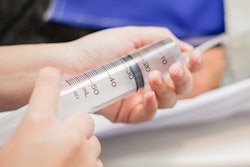
Using dual-energy CT (DECT) or simply lowering the tube voltage of standard CT can enable a 25% reduction in contrast dose for CT exams without altering image quality -- uncovering the potential for hospital-wide cost savings, according to an article published online April 9 in Radiology.
After performing a randomized trial to investigate the ideal protocol for contrast-enhanced abdominal CT scanning in patients undergoing cancer surveillance, researchers from Massachusetts General Hospital found that a 25% lower dose of iodinated oral contrast yielded acceptable bowel labeling as well as substantially higher luminal attenuation on low-kVp and low-keV CT exams, compared with the standard dose of barium-based contrast.
Currently, the American College of Radiology (ACR) and most oncology guidelines recommend the use of oral contrast medium when imaging patients are receiving treatment for cancer, and effective imaging protocols have been established for standard contrast-enhanced CT exams. Recent advances in CT technology, however, have led to the increased use of automated tube voltage selection techniques as well as DECT in order to minimize the amount of contrast dose needed for these exams, first author Dr. Anushri Parakh and colleagues noted.
Taking these advanced techniques into account, the researchers examined 200 cancer patients who had previously undergone an abdominal CT scan with a standard tube voltage of 120 kVp and enhanced with 18 grams of a barium contrast agent. Each of these patients then underwent one of four distinct follow-up CT scanning protocols: low tube voltage (100 kVp) with a standard iodine-based contrast dose (7.2 grams), low tube voltage with a 25% lower iodine dose (5.4 grams), DECT with a standard iodine dose, or DECT with a 25% lower iodine dose.
Qualitative analyses independently performed by two abdominal radiologists on a five-point Likert scale demonstrated that the image quality of the low-contrast CT protocols was nearly identical to that of the standard-dose CT protocols.
Further quantitative assessments revealed that attenuation of key regions such as the small bowel was 78% higher when using the standard iodine-based contrast protocol, compared with the barium contrast protocol. This kind of improved attenuation applied even when the iodine contrast dose was reduced by a quarter, albeit to a smaller degree (46%).
| Comparison of scanner parameters for contrast-enhanced abdominal CT | |||||
| Standard barium contrast CT at 120 kVp | Standard iodine contrast CT at 100 kVp | Reduced iodine contrast CT at 100 kVp | Standard iodine contrast DECT at 65 keV | Reduced iodine contrast DECT at 65 keV | |
| Image quality on a 5-point Likert scale | 3.2-3.5 | 3.2-3.5 | 3.2-3.5 | 3.6-3.7 | 3.6 |
| Small-bowel attenuation | 257 HU | 459 HU* | 385 HU* | 356 HU | 325 HU* |
| Volumetric CT dose index (CTDIvol) | 12 mGy | 7 mGy | 6 mGy | 15 mGy | 15 mGy |
Following the CT exams, the patients completed questionnaires describing their preferences for the iodinated versus barium contrast agents. Roughly 86% of patients claimed to prefer the iodine-based medium. In addition, the rate of adverse events, including nausea, abdominal discomfort, and reflux, was higher with barium (17.5%) than with iodine (7%) by a statistically significant degree.
Furthermore, reducing the iodine-based contrast dose by 25% could potentially lead to cost benefits estimated at $26,546 per year for a typical radiology department, which would be magnified even more with the homogenization of CT protocols across hospitals throughout a healthcare network, Parakh and colleagues noted.
"Bowel opacification obtained with a positive iodinated oral contrast medium is noninferior to that obtained by using barium, and the dose of [iodinated contrast medium] can be reduced by 25% without any compromise in bowel opacification," Dr. Andrea Laghi from Sapienza University of Rome in Italy wrote in an accompanying editorial. "Acceptance of iodinated oral contrast media, independent of dosage, is high in patients undergoing cancer treatment."



















